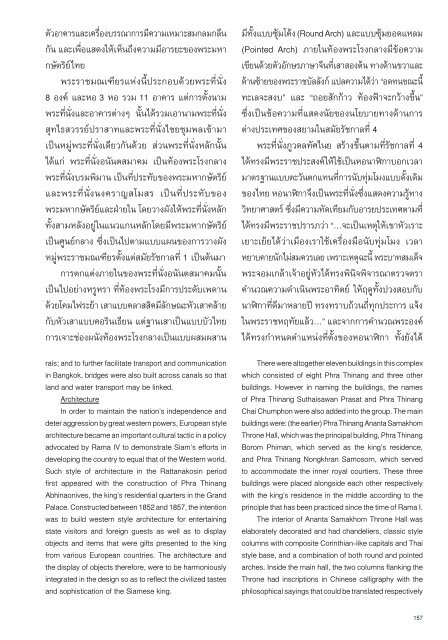บ้านเรือนถิ่นไทยในช่วงเจ็ดทศวรรษ 2489-2559
Create successful ePaper yourself
Turn your PDF publications into a flip-book with our unique Google optimized e-Paper software.
ตัวอาคารและเครื่องบรรณาการมีความเหมาะสมกลมกลืน<br />
กัน และเพื่อแสดงให้เห็นถึงความมีอารยะของพระมหา<br />
กษัตริย์ไทย<br />
พระราชมณเฑียรแห่งนี้ประกอบด้วยพระที่นั่ง<br />
8 องค์ และหอ 3 หอ รวม 11 อาคาร แต่การตั้งนาม<br />
พระที่นั่งและอาคารต่างๆ นั้นได้รวมเอานามพระที่นั่ง<br />
สุทไธสวรรย์ปราสาทและพระที่นั่งไชยชุมพลเข้ามา<br />
เป็นหมู่พระที่นั่งเดียวกันด้วย ส่วนพระที่นั่งหลักนั้น<br />
ได้แก่ พระที่นั่งอนันตสมาคม เป็นท้องพระโรงกลาง<br />
พระที่นั่งบรมพิมาน เป็นที่ประทับของพระมหากษัตริย์<br />
และพระที่นั่งนงคราญสโมสร เป็นที่ประทับของ<br />
พระมหากษัตริย์และฝ่ายใน โดยวางผังให้พระที่นั่งหลัก<br />
ทั้งสามหลังอยู่ในแนวแกนหลักโดยมีพระมหากษัตริย์<br />
เป็นศูนย์กลาง ซึ่งเป็นไปตามแบบแผนของการวางผัง<br />
หมู่พระราชมณเฑียรตั้งแต่สมัยรัชกาลที่ 1 เป็นต้นมา<br />
การตกแต่งภายในของพระที่นั่งอนันตสมาคมนั้น<br />
เป็นไปอย่างหรูหรา ที่ท้องพระโรงมีการประดับเพดาน<br />
ด้วยโคมไฟระย้า เสาแบบคลาสสิคมีลักษณะหัวเสาคล้าย<br />
กับหัวเสาแบบคอรินเธียน แต่ฐานเสาเป็นแบบบัวไทย<br />
การเจาะช่องผนังท้องพระโรงกลางเป็นแบบผสมผสาน<br />
rais; and to further facilitate transport and communication<br />
in Bangkok, bridges were also built across canals so that<br />
land and water transport may be linked.<br />
Architecture<br />
In order to maintain the nation’s independence and<br />
deter aggression by great western powers, European style<br />
architecture became an important cultural tactic in a policy<br />
advocated by Rama IV to demonstrate Siam’s efforts in<br />
developing the country to equal that of the Western world.<br />
Such style of architecture in the Rattanakosin period<br />
first appeared with the construction of Phra Thinang<br />
Abhinaonives, the king’s residential quarters in the Grand<br />
Palace. Constructed between 1852 and 1857, the intention<br />
was to build western style architecture for entertaining<br />
state visitors and foreign guests as well as to display<br />
objects and items that were gifts presented to the king<br />
from various European countries. The architecture and<br />
the display of objects therefore, were to be harmoniously<br />
integrated in the design so as to reflect the civilized tastes<br />
and sophistication of the Siamese king.<br />
มีทั้งแบบซุ้มโค้ง (Round Arch) และแบบซุ้มยอดแหลม<br />
(Pointed Arch) ภายในท้องพระโรงกลางมีข้อความ<br />
เขียนด้วยตัวอักษรภาษาจีนที่เสาสองต้น ทางด้านขวาและ<br />
ด้านซ้ายของพระราชบัลลังก์ แปลความได้ว่า “อดทนขณะนี้<br />
ทะเลจะสงบ” และ “ถอยสักก้าว ท้องฟ้าจะกว้างขึ้น”<br />
ซึ่งเป็นข้อความที่แสดงนัยของนโยบายทางด้านการ<br />
ต่างประเทศของสยามในสมัยรัชกาลที่ 4<br />
พระที่นั่งภูวดลทัศไนย สร้างขึ้นตามที่รัชกาลที่ 4<br />
ได้ทรงมีพระราชประสงค์ให้ใช้เป็นหอนาฬิกาบอกเวลา<br />
มาตรฐานแบบตะวันตกแทนที่การนับทุ่มโมงแบบดั้งเดิม<br />
ของไทย หอนาฬิกาจึงเป็นพระที่นั่งซึ่งแสดงความรู้ทาง<br />
วิทยาศาสตร์ ซึ่งมีความทัดเทียมกับอารยประเทศตามที่<br />
ได้ทรงมีพระราชปรารภว่า “...จะเป็นเหตุให้เขาหัวเราะ<br />
เยาะเย้ยได้ว่าเมืองเราใช้เครื่องมือนับทุ่มโมง เวลา<br />
หยาบคายนักไม่สมควรเลย เพราะเหตุฉะนี้ พระบาทสมเด็จ<br />
พระจอมเกล้าเจ้าอยู่หัวได้ทรงพินิจพิจารณาตรวจตรา<br />
คำนวณความดำเนินพระอาทิตย์ ให้ฤดูทั้งปวงสอบกับ<br />
นาฬิกาที่ดีมาหลายปี ทรงทราบถ้วนถี่ทุกประการ แจ้ง<br />
ในพระราชหฤทัยแล้ว...” และจากการคำนวณพระองค์<br />
ได้ทรงกำหนดตำแหน่งที่ตั้งของหอนาฬิกา ทั้งยังได้<br />
There were altogether eleven buildings in this complex<br />
which consisted of eight Phra Thinang and three other<br />
buildings. However in naming the buildings, the names<br />
of Phra Thinang Suthaisawan Prasat and Phra Thinang<br />
Chai Chumphon were also added into the group. The main<br />
buildings were: (the earlier) Phra Thinang Ananta Samakhom<br />
Throne Hall, which was the principal building, Phra Thinang<br />
Borom Phiman, which served as the king’s residence,<br />
and Phra Thinang Nongkhran Samosorn, which served<br />
to accommodate the inner royal courtiers. These three<br />
buildings were placed alongside each other respectively<br />
with the king’s residence in the middle according to the<br />
principle that has been practiced since the time of Rama I.<br />
The interior of Ananta Samakhom Throne Hall was<br />
elaborately decorated and had chandeliers, classic style<br />
columns with composite Corinthian-like capitals and Thai<br />
style base, and a combination of both round and pointed<br />
arches. Inside the main hall, the two columns flanking the<br />
Throne had inscriptions in Chinese calligraphy with the<br />
philosophical sayings that could be translated respectively<br />
157


















